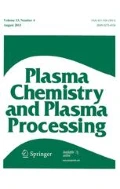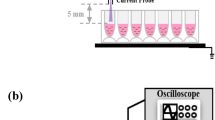Abstract
Cold atmospheric plasma (CAP) and pulsed electric field (PEF) technologies have received extensive attention for their potential beneficial effects in cancer therapy. As two emerging anticancer technologies, both CAP and PEF are related to high voltage electricity, so it is useful to compare their anticancer effects and underlying mechanism to further promote their clinical application. Here, based on three-dimensional (3D) multicellular tumor spheroids, the cytotoxicity of a He + O2 plasma jet or pulsed electric field on cancer cells was tested. It was found that the anticancer effects of the PEF mainly occurred within the first four hours of treatment, while the anticancer effects of the plasma jet were maintained for at least 24 h after irradiation. The PEF was shown to destroy the integrity of the cell membrane and selectively kill cancer cells in the S and G2/M phases, and the apoptosis was observed in the entire region of the 3D tumor spheroids. In contrast, the He + O2 plasma jet was shown to induce apoptosis by increasing cellular oxidative stress, and the apoptosis was observed only on the outermost layer of the 3D tumor spheroids.








Similar content being viewed by others
References
Chen WQ, Zheng RS, Baade PD, Zhang SW, Zeng HM, Bray F, Jemal A, Yu XQ, He J (2016) Cancer statistics in China, 2015: Cancer Statistics in China, 2015. CA-Cancer J Clin 66:115–132
Park NH, Cheng W, Lai F, Yang C, De Sessions PF, Periaswamy B, Chu CW, Bianco S, Liu SQ, Venkataraman S, Chen QF, Yang YY, Hedrick JL (2018) Addressing drug resistance in cancer with macromolecular chemotherapeutic agents. J Am Chem Soc 140:4244–4252
Ost P, Reynders D, Decaestecker K, Fonteyne V, Lumen N, De Bruycker A, Lambert B, Delrue L, Bultijnck R, Claeys T, Goetghebeur E, Villeirs G, De Man K, Ameye F, Billiet I, Joniau S, Vanhaverbeke F, De Meerleer G (2018) Surveillance or metastasis-directed therapy for oligometastatic prostate cancer recurrence: a prospective, randomized, multicenter phase II trial. J Clin Oncol 36:446–453
Schoenbach KH, Hargrave B, Joshi RP, Kolb JF, Nuccitelli R, Osgood PA, Stacey M, Swanson RJ, White JA, Xiao S, Zhang J, Beebe SJ, Blackmore PF, Buescher ES (2007) IEEE Trns. Dielectr Electr Insul 14:1088–1109
Yao CG, Sun CX, Mi Y, Xiong L, Wang SB (2004) Experimental studies on killing and inhibiting effects of steep pulsed electric field (SPEF) to target cancer cell and solid tumor. IEEE Trans Plasma Sci 32:1626–1633
Beebe SJ, Fox PM, Rec LJ, Willis LK, Schoenbach KH (2003) Faseb J 17:1493–1495
Chen XH, Ren ZG, Yin SY, Xu YN, Guo DJ, Xie HY, Zhou L, Wu LM, Jiang JW, Li HC, Sun JH, Zheng SS (2017) The local liver ablation with pulsed electric field stimulate systemic immune reaction against hepatocellular carcinoma (HCC) with time-dependent cytokine profile. Cytokine 93:44–50
Laroussi M (2014) From killing bacteria to destroying cancer cells: 20 years of plasma medicine: from killing bacteria to destroying cancer cells. Plasma Process Polym 11:1138–1141
Xu DH, Xu YJ, Cui QJ, Liu DX, Liu ZJ, Wang XH, Yang YJ, Feng MJ, Liang R, Chen HL, Ye K, Kong MG (2018) Cold atmospheric plasma as a potential tool for multiple myeloma treatment. Oncotarget 9:18002–18017
Shao T, Wang R, Zhang C, Yan P (2018) Atmospheric‐pressure pulsed discharges and plasmas: mechanism, characteristics and applications. High Voltage 3(1):14–20
Utsumi F, Kajiyama H, Nakamura K, Tanaka H, Mizuno M, Ishikawa K, Kondo H, Kano H, Hori M, Kikkawa F (2013) Effect of indirect nonequilibrium atmospheric pressure plasma on anti-proliferative activity against chronic chemo-resistant ovarian cancer cells in vitro and in vivo. PLoS ONE 8(12):e81576
Liu Y, Tan S, Zhang H, Kong X, Ding L, Shen J, Lan Y, Cheng C, Zhu T, Xia W (2017) Selective effects of non-thermal atmospheric plasma on triple-negative breast normal and carcinoma cells through different cell signaling pathways. Sci Rep 7:7980
Kong MG, Kroesen G, Morfill G, Nosenko T, Shimizu T, Dijk JV, Zimmermann JL (2009) Plasma medicine: an introductory review. New J Phys 11:115012
Lu X, Naidis GV, Laroussi M, Reuter S, Graves DB, Ostrikov K (2016) Selective killing of ovarian cancer cells through induction of apoptosis by nonequilibrium atmospheric pressure plasma. Phys Rep-Rev Sec Phys Lett 630:1–84
Iseki S, Nakamura K, Hayashi M, Tanaka H, Kondo H, Kajiyama H, Kano H, Kikkawa F, Hori M (2012) Selective killing of ovarian cancer cells through induction of apoptosis by nonequilibrium atmospheric pressure plasma. Appl Phys Lett 100:113702
Panngom K, Baik KY, Nam MK, Han JH, Rhim H, Choi EH (2013) Cell Death. Discovery 4:e642
Ratovitski EA, Cheng X, Yan D, Sherman JH, Canady J, Trink B, Keidar M (2014) Anti-cancer therapies of 21st century: novel approach to treat human cancers using cold atmospheric plasma: anti-cancer therapies of 21st century. Plasma Process Polym 11:1128–1137
Nuccitelli R, Chen X, Pakhomov AG, Baldwin WH, Sheikh S, Pomicter JL, Ren W, Osgood C, Swanson RJ, Kolb JF, Beebe SJ, Schoenbach KH (2009) A. Int J Cancer 125:438–445
Chen ZY, Liu DX, Xu H, Xia WJ, Liu ZJ, Xu DH, Rong MZ, Kong MG (2019) Decoupling analysis of the production mechanism of aqueous reactive species induced by a helium plasma jet. Plasma Sources Sci Technol 28:025001
Pakhomova ON, Khorokhorina VA, Bowman AM, Rodaite-Riseviciene R, Saulis G, Xiao S, Pakhomov AG (2012) Oxidative effects of nanosecond pulsed electric field exposure in cells and cell-free media. Arch Biochem Biophys 527:55–64
Zhang H, Zhang JS, Liu ZJ, Xu DH, Guo L, Liu DX, Kong MG (2019) Evaluation of the anticancer effects induced by cold atmospheric plasma in 2D and 3D cell‐culture models. Plasma Process Polym 16:e1900072
Zhang JS, Liu DX, Zhang H, Xia WJ, Liu YF, Sun BW, Xu DH, Guo L, Kong MG (2020) Plasma Process. Polym. e1900213.
Zhang JS, Zhang H, Liu DX, Liu YF, Sun BW, Wang ZF, Xu DH, Guo L, Kong MG (2020) Study on the anticancer area and depth of a He plasma jet based on 2D monolayer cells and 3D tumor spheroids. J Phys D-Appl Phys 53:175201
Xu ZM, Shen J, Cheng C, Hu SH, Lan Y, Chu PK (2017) In vitro antimicrobial effects and mechanism of atmospheric-pressure He/O2 plasma jet on Staphylococcus aureus biofilm. J Phys D-Appl Phys 50:105201
Tung CH, Han MS, Kim Y, Qi J, O’Neill BE (2017) Tumor ablation using low-intensity ultrasound and sound excitable drug. J Control Release 258:67–72
Feng L, He F, Dai Y, Liu B, Yang G, Gai S, Niu N, Lv R, Li C, Yang P (2017) A versatile near infrared light triggered dual-photosensitizer for synchronous bioimaging and photodynamic therapy. ACS Appl Mater Interfaces 9:12993–13008
Szili EJ, Oh J-S, Fukuhara H, Bhatia R, Gaur N, Nguyen CK, Hong S-H, Ito S, Ogawa K, Kawada C, Shuin T, Tsuda M, Furihata M, Kurabayashi A, Furuta H, Ito M, Inoue K, Hatta A, Short RD (2018) Modelling the helium plasma jet delivery of reactive species into a 3D cancer tumour. Plasma Sources Sci Technol 27(1):014001
Ma J, Zhang H, Cheng C, Shen J, Bao LZ, Han W (2017) Contribution of hydrogen peroxide to non-thermal atmospheric pressure plasma induced A549 lung cancer cell damage. Plasma Process Polym 14:e1600162
Yusupov M, Van der Paal J, Neyts EC, Bogaerts A (2017) Synergistic effect of electric field and lipid oxidation on the permeability of cell membranes. Biochim Biophys Acta-Gen Subj 1861(4):839–847
Sweeney DC, Rebersek M, Dermol J, Rems L, Miklavcic D, Davalos RV (2016) Quantification of cell membrane permeability induced by monopolar and high-frequency bipolar bursts of electrical pulses. Biochim Biophys Acta-Gen Subj 1858(11):2689–2698
Zhang H, Ma J, Shen J, Lan Y, Ding L, Qian S, Xia W, Cheng C, Chu PK (2018) Roles of membrane protein damage and intracellular protein damage in death of bacteria induced by atmospheric-pressure air discharge plasmas. RSC Adv 8:21139
Damjanovich S, Edidin M, Szöllösi J, Trón L (1994) Mobility and proximity in biological membranes. Pearl River, New York
Volotskova O, Hawley TS, Stepp MA, Keidar M (2012) Targeting the cancer cell cycle by cold atmospheric plasma. Sci Rep 2:636
Zhang H, Zhang JS, Ma J, Shen J, Lan Y, Liu DX, Xia WD, Xu DH, Cheng C (2020) Differential sensitivities of HeLa and MCF-7 cells at G1-, S-, G2- and M-phase of the cell cycle to cold atmospheric plasma. J Phys D-Appl Phys 53:125202
Liu ZC, Guo L, Liu DX, Rong MZ, Chen HL, Kong MG (2017) chemical kinetics and reactive species in normal saline activated by a surface air discharge: chemical kinetics and reactive species in normal saline. Plasma Process Polym 14:1600113
Liu X, Gan L, Ma M, Zhang S, Liu J, Chen H, Liu D, Lu X (2018) A comparative study on the transdermal penetration effect of gaseous and aqueous plasma reactive species. J Phys D: Appl Phys 51:075401
Liu DX, Liu ZC, Chen C, Yang AJ, Li D, Rong MZ, Chen HL, Kong MG (2016) Aqueous reactive species induced by a surface air discharge: Heterogeneous mass transfer and liquid chemistry pathways. Sci Rep 6:23737
Shen J, Zhang H, Xu Z, Zhang Z, Cheng C, Ni G, Lan Y, Meng Y, Xia W, Chu PK (2019) Preferential production of reactive species and bactericidal efficacy of gas-liquid plasma discharge. Chem Eng J 362:402–412
Kim SJ, Chung TH, Bea SH, Leem SH (2009) Characterization of atmospheric pressure microplasma jet source and its application to bacterial inactivation. Plasma Process Polym 6(10):676–685
Iza F, Kim GJ, Lee SM, Lee JK, Walsh JL, Zhang YT, Kong MG (2008) Microplasmas: sources, particle kinetics, and biomedical applications. Plasma Process Polym 5(4):322–344
Liu DX, He TT, Liu ZJ, Wang S, Liu ZC, Rong MZ, Kong MG (2018) Spatial-temporal distributions of ROS in model tissues treated by a He+O2 plasma jet. Plasma Process Polym 15:e1800057
Ray PD, Huang BW, Tsuji Y (2012) Reactive oxygen species (ROS) homeostasis and redox regulation in cellular signaling. Cell Signal 24:981–990
Bao P, Lu X, He M, Liu D (2016) Kinetic analysis of delivery of plasma reactive species into cells immersed in culture media. IEEE T Plasma Sci 44:2673–2681
Acknowledgements
This work was supported by the National Natural Science Foundation of China (No. 51907158, 51677147), the Natural Science Foundation of Shaanxi Province (No. 2019JQ-441), the China Postdoctoral Science Foundation (No. 2019M663714), the State Key Laboratory of Electrical Insulation and Power Equipment (Grant Nos. EIPE 19309), the Fundamental Research Funds for the Central Universities (xjh012019008).
Author information
Authors and Affiliations
Corresponding author
Additional information
Publisher's Note
Springer Nature remains neutral with regard to jurisdictional claims in published maps and institutional affiliations.
Rights and permissions
About this article
Cite this article
Zhang, H., Zhang, J., Xu, S. et al. Comparison of the Anticancer Effects of Pulsed Electric Field and He + O2 Plasma Jet. Plasma Chem Plasma Process 41, 973–987 (2021). https://doi.org/10.1007/s11090-021-10174-7
Received:
Accepted:
Published:
Issue Date:
DOI: https://doi.org/10.1007/s11090-021-10174-7




